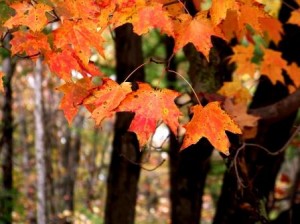
Did you ever wonder why the trees change colors or why you never see those awesome colors throughout the season? Can you tell the type of tree by the color?
The seasonal color change from shades of green to the vibrant colors begins when the amount of sunlight decreases. As the length of daylight becomes shorter, the production of chlorophyll is decreased, explained Jeanne Wambaugh, district forester with the Elk State Forest.
Further, she explained that chlorophyll, containing a green pigment, is the most abundant chemical and it is also the producer of food within leaves. When the production of chlorophyll decreases, the green color is removed, other pigments that are within the leaf emerge.
The yellow and orange colors come from the chemical called carotenoids. The carotens from this group produce bright orange color while the xanthophyllis produce yellow color. The other major chemical, anthocyanins, produces red, blue and violet color, said Wambaugh.
“This group is affected by sunlight, rainfall, temperature and acidity,” she said. “Therefore, the yellow and orange colors are fairly constant from one year to another but the red, blue and violet shades may vary.”
According to her, the fall color of the leaves can help you identify the tree. The trees that always turn yellow are from poplars, aspen, birch and hickory. She said one shouldn’t forget to note the time also, as some trees turn earlier than others. Trees that turn early are ash, cherry, willow, sugar maple, sassafras and red maple. Trees that turn late are oaks and beech.
For the optimum fall color, Wambaugh said the spring should be warm and wet, with a summer that is neither too hot nor dry and a fall with sunny days and cool nights. She said although you may not be able to alter the weather, you can still take the time get out and enjoy the beauty of the season.
Check out the current statewide fall foliage report here